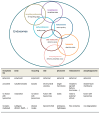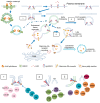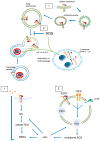Redox Signaling in Endosomes Using the Example of EGF Receptors: A Graphical Review
- PMID: 39456468
- PMCID: PMC11504029
- DOI: 10.3390/antiox13101215
Redox Signaling in Endosomes Using the Example of EGF Receptors: A Graphical Review
Abstract
Early endosomes represent first-line sorting compartments or even organelles for internalized molecules. They enable the transport of molecules or ligands to other compartments of the cell, such as lysosomes, for degradation or recycle them back to the membrane by various mechanisms. Moreover, early endosomes function as signaling and scaffolding platforms to initiate or prolong distinct signaling pathways. Accordingly, early endosomes have to be recognized as either part of a degradation or recycling pathway. The physical proximity of many ligand-binding receptors with other membrane-bound proteins or complexes such as NADPH oxidases may result in an interaction of second messengers, like reactive oxygen species (ROS) and early endosomes, that promote the correct recognition of individual early endosomes. In fact, redoxosomes comprise an endosomal subsection of signaling endosomes. One example of such potential interaction is epidermal growth factor receptor (EGFR) signaling. Here we summarize recent findings on EGFR signaling as a well-studied example for receptor trafficking and trans-activation and illustrate the interplay between cellular and endosomal ROS.
Keywords: EGFR; early endosomes; reactive oxygen species; redoxosomes; trans-activation.
Conflict of interest statement
The authors declare no conflicts of interest.
Figures





Similar articles
-
Signaling components of redox active endosomes: the redoxosomes.Antioxid Redox Signal. 2009 Jun;11(6):1313-33. doi: 10.1089/ars.2008.2363. Antioxid Redox Signal. 2009. PMID: 19072143 Free PMC article. Review.
-
Evidence for efficient phosphorylation of EGFR and rapid endocytosis of phosphorylated EGFR via the early/late endocytic pathway in a gefitinib-sensitive non-small cell lung cancer cell line.Mol Cancer. 2008 May 21;7:42. doi: 10.1186/1476-4598-7-42. Mol Cancer. 2008. PMID: 18492291 Free PMC article.
-
A role for Hrs in endosomal sorting of ligand-stimulated and unstimulated epidermal growth factor receptor.Exp Cell Res. 2004 Jul 15;297(2):380-91. doi: 10.1016/j.yexcr.2004.03.038. Exp Cell Res. 2004. PMID: 15212941
-
Lysosomal targeting of epidermal growth factor receptors via a kinase-dependent pathway is mediated by the receptor carboxyl-terminal residues 1022-1123.J Biol Chem. 1996 Nov 29;271(48):30340-6. doi: 10.1074/jbc.271.48.30340. J Biol Chem. 1996. PMID: 8939994
-
Endosomal functions in plants.Traffic. 2008 Sep;9(10):1589-98. doi: 10.1111/j.1600-0854.2008.00787.x. Epub 2008 Jul 9. Traffic. 2008. PMID: 18627577 Review.
Cited by
-
Endosomal H2O2 Molecules Act as Signaling Mediators in Akt/PKB Activation.Antioxidants (Basel). 2025 May 16;14(5):594. doi: 10.3390/antiox14050594. Antioxidants (Basel). 2025. PMID: 40427476 Free PMC article.
-
Reactive oxygen species and reactive nitrogen species are double-edged swords in Salmonella infection.Arch Microbiol. 2025 Aug 6;207(9):215. doi: 10.1007/s00203-025-04420-1. Arch Microbiol. 2025. PMID: 40768042 Review.
References
Publication types
LinkOut - more resources
Full Text Sources
Research Materials
Miscellaneous

